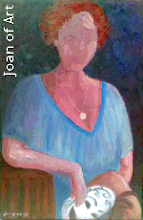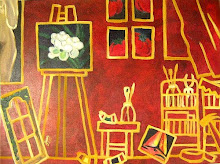
For starters, I recommend to use acrylics, because it's water-based, thus safe to use for children.
1. Easel - I prefer my students standing while painting to allow more freedom of movement and in order for them to step back once in a wile to see their painting from a distance.
2. Apron or working clothes - expect paint splatters all over your clothes and skin so better protect them with an apron or better, wear old clothes while at work.
3. Canvas - buy by the meter at this telahan at the atrium beside centroplex in central market (I forgot the name! daw ong pio, I think?)
4. Canvas stretcher - your choice between two types:
a. Plywood stretcher - get the thinnest plywood you can get, ang pwede mautod sang cutter, no need lagare. It costs about P220 the whole 8ft x 4 ft, that should give you a lot of standard 18"x24" cuts (please do the math na lang kun pila). Then cut some of the 18"x24" into four 9"x12" cuts for the smaller works, or half lang at 12"x18". Now you have at least three sizes to work on. However, you must have to frame this after your artwork is done.
b. Bastidor - for smaller 9"x12" or even 18"x24" works you can use the 1"x1" and 1"x2" for the bigger ones. Kay natak-an na ko ya magpalopez-jaena to buy the gemelina lumber, sa citi hardware na ako gapamakal kahoy para nasapiyo na. But I heard other artists have their bastidor frames made at lopez-jaena at a reasonable price, without the canvas pa. The advantage of working on the bastidor is that you don't have to frame it unless you really want to, and the "bounce" of a backingless canvass is more preferred by artists than the hard press of the plywood-backed canvas.
*Note - How to stretch your canvas: it is best to staple your canvas with a gun tacker starting from the center on one side, then the center of the opposite side, then from the center of the other side, then its opposite side, working on to the corners, as shown in this illustration. If you have time, please observe how the other canvas are neatly and tightly stretched in place. Soon you will be able to get the hang of it and even develop your own stretching technique.
*Note - How to prime your canvas: in lieu of acrylic gesso which is not available in the local market, we use white DAVIES acrylic semi-gloss, as advised by our mentor for a more vibrant underpainting. We are taught to put value to our painting so that even the things that are not seen in painting have to be already good in order to give your artwork a good foundation and the luster that other paintings don't seem to have. Paint your canvas with three layers of paint but you may add more up to five coats for a better primed canvas support. Let dry. Now you are ready to use your primed canvases for your painting.
*Note - another excellent painting support is lawanit or hardboard, which is very acceptable and even better than canvas because of its more rigid surface. In fact, many of the old paintings that survived have been painted on wood panels. You have the option to paint on either side of the lawanit. Although I prefer the rough side for texture, you can also choose to paint on the smooth side, just sand it before coating it with gesso or acrylic primer and in between layers.
5. Brushes - for starters, choose cheap nylon brushes (the red sable ones) available at national bookstore. There are rounds, flats, and other types of brushes. Choose several types of various sizes. The more you paint the more you will discover a particular liking to a certain brush type/size.
6. paints - for starters, choose mid-range acrylic brands such as Reeves, Liquitex, and Grumbacher which is the ones easily available in the local market. If you buy cheap paint, you might regret it because their pigment quality are not as vibrant. Always put value to your painting so it is better to start with mid-range quality paints and move up to the more expensive ones when you have mustered more and more confidence. There are two kinds of paints, the artist grade and the student grade. The latter has less pigment because it contains more extenders. The former is of course more expensive because of its more concentrated pigments. It's your choice then which to buy. You may also buy by boxes of 12, 16 or 24 colors, but always buy an extra tube of white color. you'll be surprised at how much you will be needing a lot of white in your painting. It is better though, to buy the big individual tubes as long as you have all of these colors:
a. red
b. yellow
c. blue
c. yellow ochre
d. burnt sienna (dark brown)
e. white x 2 or 3
You may or may not buy a tube of basic green. Note: some would advise to buy only latex paint by the can, which is the cheapest acrylic paint. That may also be an option but it is not a good idea if you want to preserve your painting for a long time. But it would be fun to spill latex paint all over just for the heck of it. you can try the new elastomeric acrylics by sun and rain because it has a built in primer unlike the old latex tinting colors which has to have white as binder in order for it to stay. Primary colors red, yellow, blue, and white and also black will do.
For your tube paints, don't buy black. Real artists never use ready-made black. We will learn how to mix our own, more dramatic black.
7. Palette - cheap plastic ones at national bookstore will do. Or any old glass plate will also serve the purpose.
8. Water mister - the kind you spray your orchids, no fertilizers, of course. This will help delay the drying of acrylics because unlike oil, acrylics dry fast. Because we don't have retarders (chemical solution that is added to acrylics to delay drying time), we use water to extend the wetness of acrylics.
9. Old cloth - to wipe away paint splatters and mistakes.
10. Old newspapers - to protect the floor.
11. Sketch pad - for sketching your studies.
12. Mongol 2 pencil - for sketcing. no erasers, no rulers. we do freehand drawing. the more mistakes, the more learning!
13. Original photographs - for originality and copyright concerns.
14. Water containers - for washing your brushes (old mugs or clean gatorade bottles will do)
15. Mineral water jug caps - or gatorade bottlecaps or similar containers for smaller dips to control water splashes (and to conserve mineral water which we will use in the actual painting).
16. Old wine bottles - for still life arrangements
17. Round fruit - for still life arrangements (because they have simpler shapes than a bunch of bananas or a pineapple, unless you are ready for the challenge)
*module - my art lessons are based on God's creation, therefore...
The First Day
Night and day - a study of light and shadows. 1 session.
The Second Day
The separation of the waters - a study of seascapes and cloudscapes. 1 session.
The first appearance of dry ground - a study of landscapes, trees, flowers. 2 sessions.
The Fourth Day
With the sky now clear, the sun, moon and stars were dependably visible. 1 session.
The Fifth Day
Great numbers of birds and sea creatures - a study of birds and fishes. 2 sessions.
The Sixth Day
Vast numbers of land animals. Man - a study of animals, man (face and whole body). 3 sessions. Total: 10 sessions.
God rested from all the work of creating that He had done - exhibition (optional).
Fee: P100/pax if more than two students, P150/pax if one or two students only. On a per session basis, because you can never really count the hours when you're painting.


